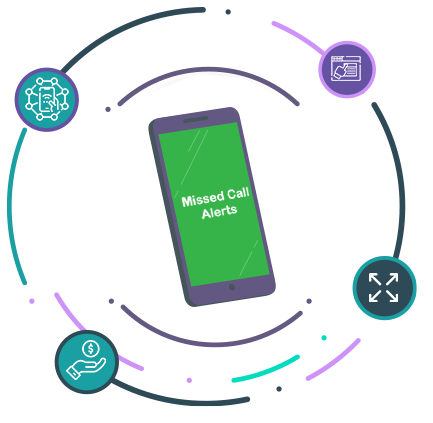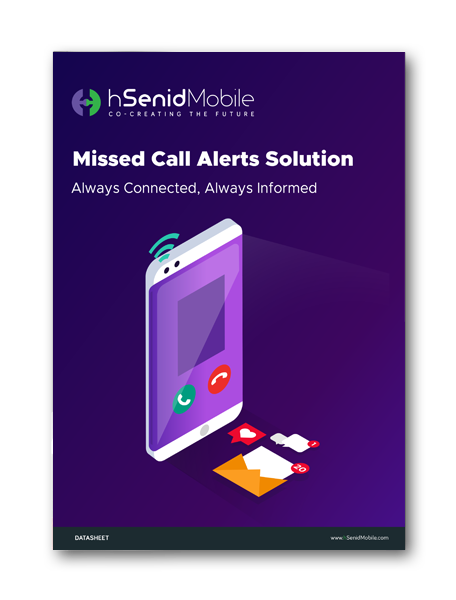In rural and semi-urban areas, where internet penetration and smartphone usage are still limited, missed call alert services have emerged as a powerful tool for banks to maintain customer trust and engagement. Rural banking customers often rely heavily on basic mobile phones and inconsistent network coverage, making it difficult to stay updated on account activities. This is where missed call alerts, simple yet effective SMS notifications about missed incoming calls, play a crucial role in ensuring seamless communication between financial institutions and their customers.
Bridging the Communication Gap in Rural Banking
For millions of rural customers, access to consistent mobile connectivity can be a challenge. According to GSMA Intelligence, over 600 million people in rural areas globally still depend on 2G networks. In such regions, mobile-based services that don’t rely on data, like missed call alerts,are essential in keeping customers informed and connected.
Banks are using missed call alert systems to build dependable relationships with customers who might not have access to smartphones or banking apps. When a customer tries to contact the bank but cannot get through due to poor signal, they receive an SMS alert confirming the missed attempt. This simple notification reassures customers that their call has been acknowledged, reducing frustration and increasing confidence in the bank’s responsiveness.
How Missed Call Alerts Strengthen Trust
Trust is the foundation of banking, especially in communities where people are traditionally hesitant to engage with formal financial institutions. A reliable missed call alert system allows banks to demonstrate attentiveness and reliability, even in low-connectivity areas.
For instance:
- Customers can receive instant alerts if their call to a bank branch or customer care number was missed, ensuring they know the institution is aware of their query.
- Loan officers in rural banking programs can stay updated on customer communications, improving follow-ups and loan servicing.
- Financial literacy campaigns can use missed call triggers for outreach,customers give a missed call to a number and receive educational messages or updates in their preferred language.
This constant communication loop reassures customers that the bank is always reachable, nurturing long-term trust and loyalty.
Statistics That Tell the Story
- A 2024 Deloitte study found that 70% of rural banking customers prefer mobile-based communication over in-person visits due to convenience.
- Around 86% of rural households in developing economies own at least one mobile phone, even if internet usage is low.
These numbers highlight why missed call alerts are not just a telecom feature but a financial inclusion tool that enhances communication and confidence between banks and their customers.
Use Cases: Rural Banking Success Stories
- Microfinance Institutions (MFIs):
MFIs often serve clients in remote regions where connectivity issues are common. By deploying missed call alerts, they ensure borrowers stay informed about repayment schedules or loan approvals, even when calls go unanswered. - Cooperative Banks:
Local cooperative banks can use missed call alerts to notify farmers about loan disbursements, subsidy credits, or account balance changes without needing an internet connection. - Mobile Banking Platforms:
For mobile-first banks, integrating missed call alert services ensures that every call attempt from a customer is recorded, improving customer service efficiency and accountability.
In each case, missed call alerts serve as a bridge, connecting banks to their rural clientele through the simplest possible technology: SMS.
Why Banks Choose hSenid Mobile’s Solution
To deliver such dependable services, banks require a telecom-grade platform capable of handling large-scale communications with minimal downtime. That’s where hSenid Mobile’s Missed Call Alerts (MCA) solution stands out.
The solution offers:
- Instant notifications: Alerts are sent in real time when a customer’s call is missed due to network issues, ensuring quick follow-up.
- Multilingual support: Banks can deliver alerts in local languages, essential for engaging rural populations.
- Scalability: Designed to manage millions of users, the system grows with the bank’s customer base.
- Seamless integration: Built to work smoothly with existing network infrastructures through core signaling stacks and SIGTRAN Gateways.
- Revenue opportunities: Banks can monetize value-added features through subscription-based services.
These capabilities make hSenid’s MCA solution a trusted choice for financial institutions aiming to expand their footprint in underserved markets while maintaining top-tier reliability and efficiency.
The Role of Technology in Building Financial Inclusion
Financial inclusion depends not only on access to accounts but also on reliable communication between banks and their customers. Missed call alerts have become a low-cost yet high-impact enabler of this trust. By ensuring customers always know when they’ve tried to connect,and that their call hasn’t gone unnoticed,banks foster a sense of reliability even without internet access.
This approach aligns perfectly with the digital transformation goals of modern financial institutions. As more banks embrace hybrid banking models that combine mobile, online, and physical services, missed call alerts ensure that even the most remote customer is not left behind.
Future Outlook: Smarter Connectivity for Rural Customers
As 5G and IoT technologies expand, the role of basic mobile services will continue to evolve. Yet, simplicity remains powerful. Missed call alerts will continue to be vital in connecting banks with rural populations, particularly where smartphone adoption remains slow.
In the near future, we can expect banks to integrate missed call alerts with AI-driven communication platforms, automating responses, sending personalized SMS replies, and analyzing call patterns to improve service delivery. The ultimate goal remains clear: ensuring that every customer interaction, no matter how small, reinforces trust and accessibility.
Conclusion: Building Trust Through Every Missed Call
For rural customers, trust in banking grows through consistency, accessibility, and communication. Missed call alert systems deliver all three, providing banks with an invaluable channel to engage and reassure customers even when traditional connectivity fails. By adopting robust solutions like hSenid Mobile’s Missed Call Alerts, financial institutions can enhance their reputation, streamline communication, and contribute to greater financial inclusion.
To empower your network with secure, reliable, and scalable telecom integrations, explore hSenid’s MCA and other connectivity solutions designed for the future of digital communication. Learn more at hSenid Missed Call Alerts Solution








